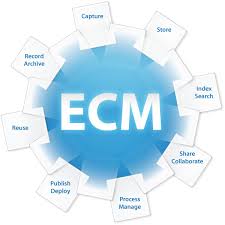enterprise content management (ECM)
Simplified ECM
Enterprise content management (ECM) is a set of defined processes that allow a corporation, agency or organization to obtain, organize, store and deliver information crucial to its operation in the most effective manner possible.
Primary Goal
A primary goal of ECM is to eliminate ad hoc processes that can expose an organization to regulatory compliance risks and other potential problems. Full-function ECM systems include features such as document and records management, content taxonomies, auditing capabilities, check-in/check-out and other workflow controls and security mechanisms.
Company Governance
ECM Library provides archiving options that give database
administrators the control to manage the archive process.
Based on the policies of a company, administrators can identify
the file types and directories to always archive,
overriding user archive decisions to ensure all the relevant
data is archived for future company reference.
Archive Intellect is a content aware classification
methodology in ECM Library that helps companies create a
repeatable method of classifying and storing unstructured
information. Intelligent archiving helps companies meet
corporate retention requirements and enforce records management
policies. Once data is classified, enforcement technology
applies retention and expiry rules provided by administrators
across different content archives to ensure it is kept only as
long as it is needed. But this too can be edited and changed by
an administrator. This helps control operational costs, as the
size of the archive is automatically controlled. ECM Library can
also be setup to “migrate and remove” expired content to a
separate repository or remove it all together.
Image Management
According to the Association for Information and Image Management (AIIM), ECM can be broken down into five major components called capture, manage, store, preserve and deliver. The purpose of each component can be briefly defined as follows:
- Capture: Create, obtain and organize information.
- Manage: Process, modify and employ information.
- Store: Temporarily back up frequently changing information in the short term.
- Preserve: Back up infrequently changing information in the medium and long term.
- Deliver: Provide clients and end users with requested information.
An effective ECM can streamline access, eliminate bottlenecks, optimize security, maintain integrity and minimize overhead.
The first step is to document all the types of content that the organization deals with, the business processes it's part
of and who handles it. ECM software tools can be used to identify duplicate and near-duplicate content, allowing the
organization to keep a few copies of a particular piece of content instead of hundreds.
eDiscovery and Investigations
ECM has become increasingly important and complex in recent years for a number of reasons. Financial fraud and data breaches -- and regulations designed to prevent them -- have made effective information governance essential not only for compliance reasons, but also to help protect the organization's reputation. Enterprises also need to manage content effectively for integration with business intelligence/business analytics (BI/BA) applications that help them to use the available information to guide business decisions.
|
Product Brief Papers
ECM
Library Discovery Product Brief

|

